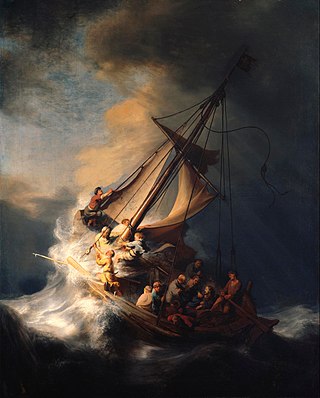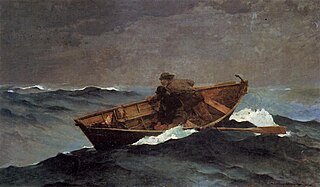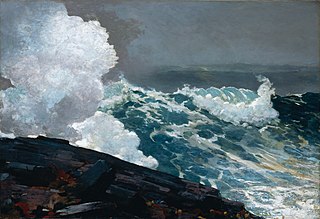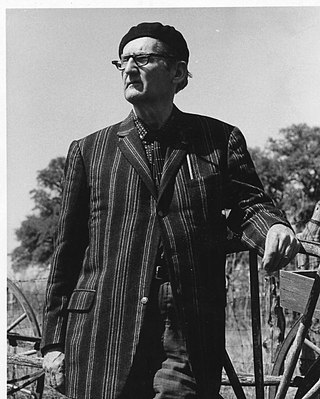
Winslow Homer was an American landscape painter and illustrator, best known for his marine subjects. He is considered one of the foremost painters of 19th-century America and a preeminent figure in American art in general.

A rip tide, or riptide, is a strong offshore current that is caused by the tide pulling water through an inlet along a barrier beach, at a lagoon or inland marina where tide water flows steadily out to sea during ebb tide. It is a strong tidal flow of water within estuaries and other enclosed tidal areas. The riptides become the strongest where the flow is constricted. When there is a falling or ebbing tide, the outflow water is strongly flowing through an inlet toward the sea, especially once stabilised by jetties.

Ivan Konstantinovich Aivazovsky was a Russian Romantic painter who is considered one of the greatest masters of marine art. Baptized as Hovhannes Aivazian, he was born into an Armenian family in the Black Sea port of Feodosia in Crimea and was mostly based there.

William Merritt Chase was an American painter, known as an exponent of Impressionism and as a teacher. He is also responsible for establishing the Chase School, which later became the Parsons School of Design.

A seascape is a photograph, painting, or other work of art which depicts the sea, in other words an example of marine art. The word originated as a formation from landscape, which was first used for images of land in art. By a similar development, "seascape" has also come to mean actual perceptions of the sea itself. It is applied in planning contexts to geographical locations possessing a good view of the sea. Seascape aesthetics receive legal protection in terms of biodiversity/ health of the seas (the OSPAR Convention, and in terms of the visual bio-cultural seascape.

Marine art or maritime art is a form of figurative art that portrays or draws its main inspiration from the sea. Maritime painting is a genre that depicts ships and the sea—a genre particularly strong from the 17th to 19th centuries. In practice the term often covers art showing shipping on rivers and estuaries, beach scenes and all art showing boats, without any rigid distinction – for practical reasons subjects that can be drawn or painted from dry land in fact feature strongly in the genre. Strictly speaking "maritime art" should always include some element of human seafaring, whereas "marine art" would also include pure seascapes with no human element, though this distinction may not be observed in practice.

Christ in the Storm on the Sea of Galilee is a 1633 oil-on-canvas painting by the Dutch Golden Age painter Rembrandt van Rijn. It is classified as a history painting and is among the largest and earliest of Rembrandt's works. It was purchased by Bernard Berenson for Isabella Stewart Gardner in 1869 and was displayed at the Isabella Stewart Gardner Museum in Boston before its theft in 1990; it remains missing. The painting depicts the biblical event in which Jesus calmed the storm on the Sea of Galilee, as is described in the fourth chapter of the Gospel of Mark. It is Rembrandt's only seascape.

Right and Left is a 1909 oil on canvas painting by the American artist Winslow Homer. It depicts a pair of common goldeneye ducks at the moment they are hit by a hunter's shotgun blast as they attempt to take flight. Completed less than two years before his death, it was Homer's last great painting, and has been the subject of a variety of interpretations regarding its origin, composition and meaning. As with his other late masterworks, it represents a return to the sporting and hunting subjects of Homer's earlier years, and was to be his final engagement with the theme. Its design recalls that of Japanese art, and the composition resembles that of a colored engraving by John James Audubon.

Abraham Jacob Bogdanove was an American artist, mural painter, and teacher best known for his seascape paintings of the Maine coast, particularly around Monhegan Island.

Breezing Up (A Fair Wind) is an oil painting by American artist Winslow Homer. It depicts a catboat called the Gloucester chopping through that city's harbor under "a fair wind" (Homer's original title). Inside the boat are a man, three boys, and their catch.

Morning at Grand Manan is an 1878 oil painting by Alfred Thompson Bricher. It is part of the permanent collection at the Indianapolis Museum of Art, and is currently on view in the Paine Early American Painting Gallery.
Cynthia Knott is a painter known for her horiztonally-oriented seascapes which recall the "multiforms" of Mark Rothko and the later work of J. M. W. Turner.

Farquhar McGillivray Knowles, also known as F. McGillvray Knowles, was a Canadian painter. He was best known for his seascapes.

The Fog Warning is one of several paintings on marine subjects by the late-19th-century American painter Winslow Homer (1836–1910). Together with The Herring Net and Breezing Up, painted the same year and also depicting the hard lives of fishermen in Maine, it is considered among his best works on such topics.

Lost on the Grand Banks (1885) is one of several paintings on marine subjects by the American painter Winslow Homer (1836–1910). Together with The Herring Net and The Fog Warning, painted in the same year, it depicts the hard lives of North Atlantic fishermen in Prouts Neck, Maine. The painting was bought in 1998 by Bill Gates, then-chairman of Microsoft, who reportedly paid $30 million for the seascape, at the time a record price for an American painting.

Northeaster is one of several paintings on marine subjects by the late-19th-century American painter Winslow Homer. Like The Fog Warning and Breezing Up, he created it during his time in Maine. It is on display in the Metropolitan Museum of Art in New York. Viewers are presented a struggle of elements between the sea and the rocky shore. Winslow Homer excelled in painting landscape paintings that depicted seascapes and mountain scenery.

Arthur William Wilson was an American artist who painted under several known pseudonyms, including Winslow Wilson and Pico Miran. In Gloucester, Wilson/Miran has been considered an early actor in the Post Modern Art Movement. He is widely quoted from his Manifesto For Post-Modern Art, published in 1951, under the name Pico Miran.

Moonlight, Wood Island Light is a late 19th-century oil painting by American artist Winslow Homer. The painting is in the collection of the Metropolitan Museum of Art in New York.

Ground Swell is a 1939 painting by American artist Edward Hopper which depicts five people on a heeling catboat in a light swell, looking at an ominous buoy. It was in the collection of the Corcoran Gallery of Art from 1943 until it was purchased by the National Gallery of Art in Washington, D.C. in 2014.
Seascape (Slightly Cloudy) is an oil-on-canvas painting executed in 1969 by German artist Gerhard Richter. It depicts a cloudy sky in grey, white and blue tones over a deep, elongated horizon line and a grey, mirror-smooth surface of the sea. The painting is signed, dated and numbered 239-2 Richter 1969 on the reverse. It his held at the Louis Vuitton Foundation, in Paris.

















